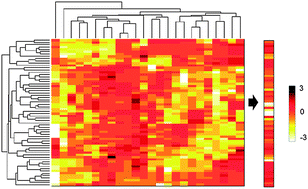Correlating phosphoproteomic signaling with castration resistant prostate cancer survival through regression analysis†
Abstract
Prostate cancer most commonly presents as initially castration dependent, however in a minority of patients the disease will progress to a state of castration resistance. Here, approaches for correlating alterations in the phosphoproteome with androgen independent cell survival in the LNCaP, PC3, and MDa-PCa-2b cell lines are discussed. The performance of the regression techniques multiple linear, ridge, principal component, and partial least squares regression is compared. The predictive performance of these algorithms over randomized data sets and using the Akaike Information Criterion is explored, and principal component and partial least squares regression are found to outperform other regression approaches. The effect of altering the number of features versus observations on the R2 value and predictive performance is also examined using the partial least squares regression model. Utilizing these approaches “drivers” of castration resistant disease can be identified whose modulation alters phenotypic outcomes. These data provide an empirical comparison of the various considerations when statistically analyzing phosphorylation data with the aim of correlating with phenotypic outcomes.


 Please wait while we load your content...
Please wait while we load your content...